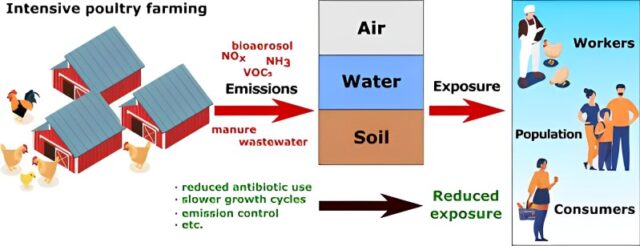
JAI PRAKASH and B.L. SAINI

Assistant professor, department of Livestock production management, SCOVAS, Jhajjar, Haryana
Assistant professor, department of Animal genetics and breeding, SCOVAS, Jhajjar, Haryana
Introduction:The environment provided to poultry flocks has a great bearing on flock performance and profitability. The internal body temperature in the adult chicken is 105°F-107°F (40.6° and 41.7°C). Newly hatched chick- 103.5°F (39.7°C) and increases daily until it reaches a stable level at about three weeks of age. Bird produces heat that must be lost to the environment to maintain constant body temperatures.Basic environment consists of feed, lighting, air (temperature,humidity, pathogen concentration and ammonia), water and litter quality. The poultry thermal comfort zone, or thermoneutrality, depends on species and age, with younger birds responding better to warmer temperatures. Poultry feed conversion deteriorates when temperatures are outside the recommended comfort zone.
Environmentally controlled house (EC house):

Environmentally controlled poultry houses are designed to operate such that the environmental conditions of temperature, relative humidity, ammonia, carbon dioxide, wind velocity, light etc. are automatically maintained as near as possible to the optimum range required by the birds. It is one in which inside conditions are maintained as near as to the bird’s optimum requirements. In modern environmentally controlled house, all the environmental requirements are controlled through various computerized sensing devices and operate automatically. A closed building, longitudinally preferably east to west, big exhaust fans on west side, evaporative cooling pads on east side along with automatic feeding and drinking systems inside, in order to maintain proper ventilation, temperature, relative humidity and lighting program.

1. Temperature control in environmentally controlled house: Different types of heaters are used for supplemental heating in poultry houses including radiant, space, and make-up air heaters.
2. Lighting management in environmentally controlled house: Environmentally controlled house must be lightproof; that is, no outside light should be allowed to inter in the building. A monitoring and control system should provide scheduling of lights that is easy to use. It is especially important breeding facilities for precise lighting schedules to be followed. A system than can pre-program lighting schedules over the life of the flock is very useful for management. It is also important to provide the desired intensity of light.
3. Cooling system in the house: When temperature increases above 850F (29.40C) then for providing comfortable environment to the birds cooling system are required.
There are four methods of cooling in the poultry houses –
- Low pressure fogging system:
- Pad –and- fan system:
- Pressurized system
- Vacuum system
- Fog –and- fan system
- High pressure nozzel system
4. Feeding in environmentally controlled house: Normally 7- 8 times per day feeding occur in environmentally controlled houses. Feed monitoring systems are available to measure the amount of feed consumed by bird.
Advantages:Followings are the chief advantages of EC house.
- There is no seasonal influence on the performance of birds
- Feed efficiency is better
- Birds are most comfortable and remain healthy.
- Growth/egg production is higher
- More birds can be kept per unit land and area.
Disadvantages: Followings are the chief Disadvantages of EC house
- Uninterrupted power supply is needed
- Huge losses may occur in case of power failure.
- Initial cost is very high
Conclusion: Artificial climate-controlled condition improves the bird’s performance with better FCR and livability percentage that translates to higher income than in conventional type. Broilers reared on floor near vent area exhibited better growth performance with optimum feed intake leading to best FCR as compared to those of cages placed in the middle and fan area. Power cost is the most expensive component in operating a climate-controlled poultry house. The investment cost per bird though higher in EC housing system but returns are also significantly higher on a long run due to higher standards of production and lower mortality. In tropical climatic conditions EC will be future trend in due to unpredictable climatic changes.
















